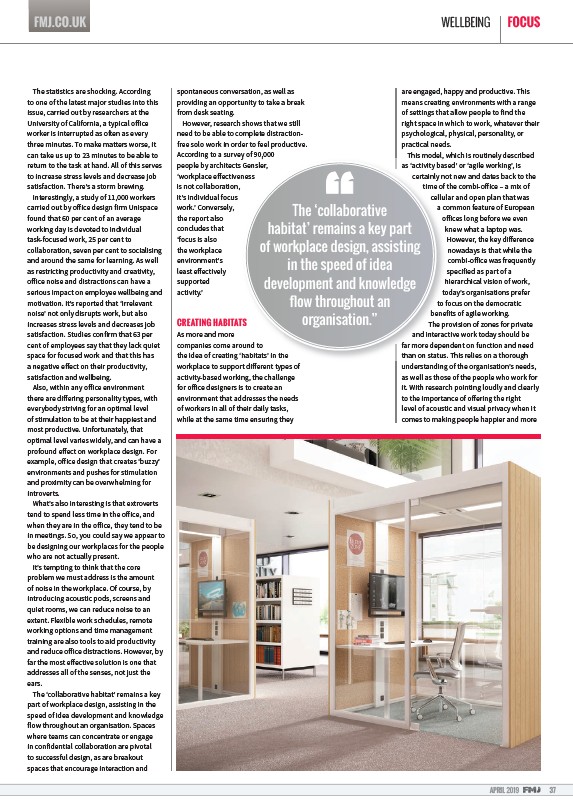
FMJ.CO.UK WELLBEING FOCUS
APRIL 2019 37
The statistics are shocking. According
to one of the latest major studies into this
issue, carried out by researchers at the
University of California, a typical o ice
worker is interrupted as o˜ en as every
three minutes. To make matters worse, it
can take us up to 23 minutes to be able to
return to the task at hand. All of this serves
to increase stress levels and decrease job
satisfaction. There’s a storm brewing.
Interestingly, a study of 11,000 workers
carried out by o ice design firm Unispace
found that 60 per cent of an average
working day is devoted to individual
task-focused work, 25 per cent to
collaboration, seven per cent to socialising
and around the same for learning. As well
as restricting productivity and creativity,
o ice noise and distractions can have a
serious impact on employee wellbeing and
motivation. It’s reported that ‘irrelevant
noise’ not only disrupts work, but also
increases stress levels and decreases job
satisfaction. Studies confirm that 63 per
cent of employees say that they lack quiet
space for focused work and that this has
a negative e ect on their productivity,
satisfaction and wellbeing.
Also, within any o ice environment
there are di ering personality types, with
everybody striving for an optimal level
of stimulation to be at their happiest and
most productive. Unfortunately, that
optimal level varies widely, and can have a
profound e ect on workplace design. For
example, o ice design that creates ‘buzzy’
environments and pushes for stimulation
and proximity can be overwhelming for
introverts.
What’s also interesting is that extroverts
tend to spend less time in the o ice, and
when they are in the o ice, they tend to be
in meetings. So, you could say we appear to
be designing our workplaces for the people
who are not actually present.
It’s tempting to think that the core
problem we must address is the amount
of noise in the workplace. Of course, by
introducing acoustic pods, screens and
quiet rooms, we can reduce noise to an
extent. Flexible work schedules, remote
working options and time management
training are also tools to aid productivity
and reduce o ice distractions. However, by
far the most e ective solution is one that
addresses all of the senses, not just the
ears.
The ‘collaborative habitat’ remains a key
part of workplace design, assisting in the
speed of idea development and knowledge
flow throughout an organisation. Spaces
where teams can concentrate or engage
in confidential collaboration are pivotal
to successful design, as are breakout
spaces that encourage interaction and
spontaneous conversation, as well as
providing an opportunity to take a break
from desk seating.
However, research shows that we still
need to be able to complete distractionfree
solo work in order to feel productive.
According to a survey of 90,000
people by architects Gensler,
‘workplace e ectiveness
is not collaboration,
it’s individual focus
work.’ Conversely,
the report also
concludes that
‘focus is also
the workplace
environment’s
least e ectively
supported
activity.’
CREATING HABITATS
As more and more
companies come around to
the idea of creating ‘habitats’ in the
workplace to support di erent types of
activity-based working, the challenge
for o ice designers is to create an
environment that addresses the needs
of workers in all of their daily tasks,
while at the same time ensuring they
are engaged, happy and productive. This
means creating environments with a range
of settings that allow people to find the
right space in which to work, whatever their
psychological, physical, personality, or
practical needs.
This model, which is routinely described
as ‘activity based’ or ‘agile working’, is
certainly not new and dates back to the
time of the combi-o ice – a mix of
cellular and open plan that was
a common feature of European
o ices long before we even
knew what a laptop was.
However, the key di erence
nowadays is that while the
combi-o ice was frequently
specified as part of a
hierarchical vision of work,
today’s organisations prefer
to focus on the democratic
benefits of agile working.
The provision of zones for private
and interactive work today should be
far more dependent on function and need
than on status. This relies on a thorough
understanding of the organisation’s needs,
as well as those of the people who work for
it. With research pointing loudly and clearly
to the importance of o ering the right
level of acoustic and visual privacy when it
comes to making people happier and more
The ‘collaborative
habitat’ remains a key part
of workplace design, assisting
in the speed of idea
development and knowledge
fl ow throughout an
organisation.”